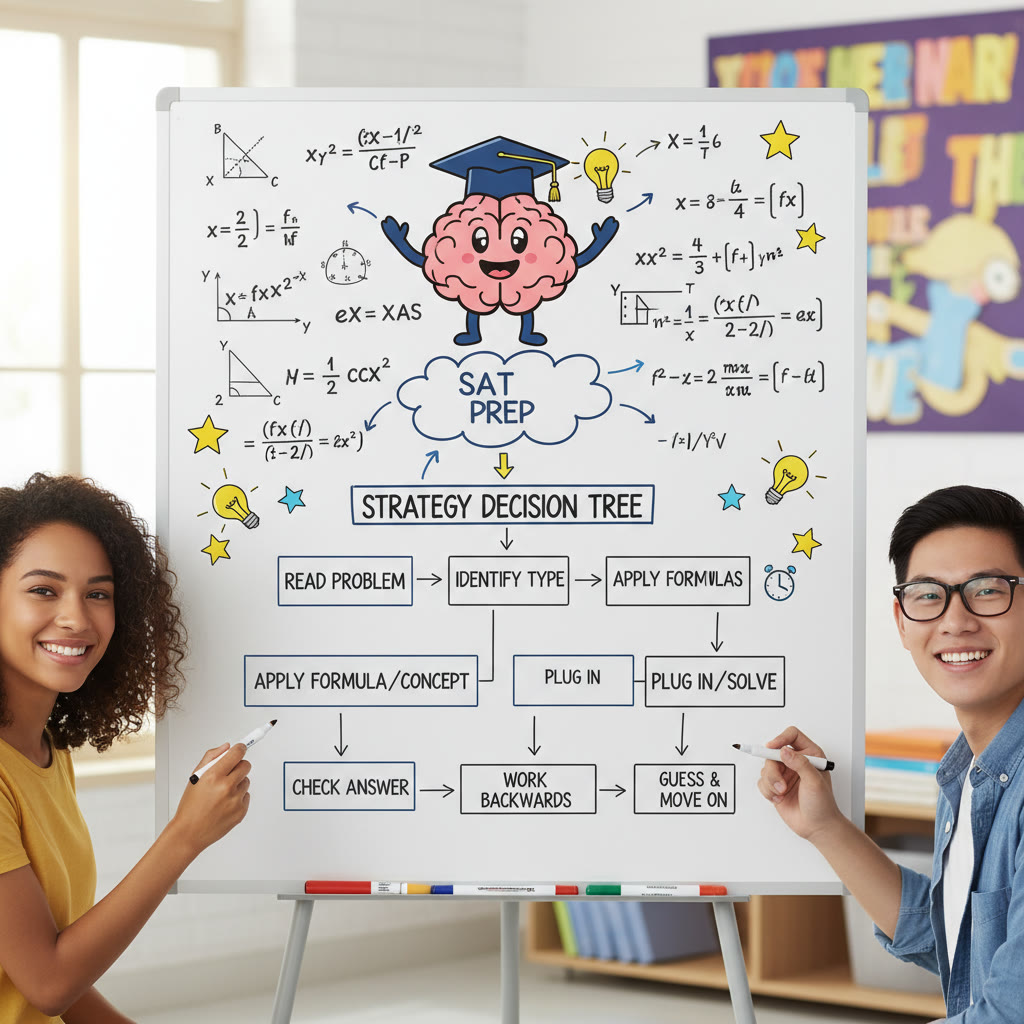How to Identify and Fix Weak Spots in SAT Preparation
Walking into the SAT is a lot like stepping onto a stage: you want to know your lines, your cues, and where the trapdoors are. Most students spend months practicing, but not all practice is equal. The difference between aimless reviewing and smart improvement is knowing exactly where you trip up and attacking those spots with a surgical plan. This guide walks you through how to identify your SAT weak spots, why they matter, and—most importantly—how to fix them efficiently so your score climbs steadily and confidently.
Why identifying weak spots is more important than more hours
Putting in hours matters, but what those hours look like matters more. Ten unfocused hours reviewing random questions rarely beats three focused hours targeting patterns in your mistakes. When you identify weak spots, you transform vague effort into precise action: you stop guessing at what to study and start working on things that actually move your score.
How to diagnose your weak spots: a practical checklist
Start with reliable data. Here’s a checklist to turn intuition into evidence.
- Take a full-length, timed practice test under realistic conditions. This is your baseline.
- Track every mistake. Don’t just circle them—note the question type, time taken, and the reason for the error.
- Analyze timing patterns. Did you rush the last 10 math questions? Did reading passages take too long?
- Compare sections. Maybe your score is balanced, or maybe one section is pulling you down.
- Look for clusters. Repeated mistakes on sentence structure, algebraic manipulation, inference questions, or graph interpretation point to real weak spots.
- Re-test after two weeks of targeted practice to confirm progress or adjust the plan.
Key signals of different types of weak spots
Not all errors are created equal. The cause behind a wrong answer determines the best fix.
- Careless errors: Silly arithmetic, misreading a word, or mis-copying an answer. These often look random and are spread across sections.
- Concept gaps: Consistent mistakes on a type of problem—like quadratics, parallel lines, or comma rules—suggest a knowledge gap.
- Time management issues: You know how to solve problems but run out of time. Look for long solution times and skipped questions.
- Strategy errors: Using a weaker approach (like plugging in numbers when elimination would be faster) can turn solvable items into time traps.
- Reading-comprehension traps: Wrong answers that are plausible but unsupported by the passage indicate inference or evidence skills that need work.
Step-by-step process to identify your weakest areas
Step 1 — Run a structured diagnostic test
Take one full-length practice SAT in real time. Treat it as the real thing: quiet room, timed sections, and no interruptions. After you finish, don’t jump into the next test. The power is in analysis.
Step 2 — Create an error log
Use a simple table or spreadsheet and record each incorrect or guessed question with columns like:
- Section (Math/Reading/Writing)
- Question type (algebra, geometry, command of evidence, etc.)
- Time spent
- Why you missed it (careless, concept, strategy, time)
- Planned fix (review rule, practice set, timed drill)
Step 3 — Look for patterns, not single mistakes
If two or three questions from a single passage trip you up, that’s noise. If seven out of ten algebra questions are wrong or slow, that’s a pattern. Focus on patterns. The table below shows a small example of how to codify your findings.
| Weak Spot | Signal (from error log) | Root Cause | Initial Fix |
|---|---|---|---|
| Linear equations with fractions | 5/8 errors in last math section; long solution times | Procedural mistakes simplifying fractions | Targeted practice: 20 problems, fraction techniques, write-step method |
| Inference questions in Reading | Wrong on plausible but unsupported options | Relying on prior knowledge rather than text evidence | Practice evidence highlighting and paraphrase drills |
| Comma splice/Run-on errors (Writing) | 3/5 grammar errors misjudged on test | Confusion about independent clause structure | Mini-lesson + 30 editing problems, explain your corrections aloud |
This document becomes your map. Revisit it after every practice test.
How to fix different kinds of weak spots
Fixing concept gaps
When an idea is missing or shaky—like the difference between mean and median, or how to tackle quadratic formula problems—play teacher. Break the concept into bite-sized rules and then practice deliberately.
- Start with a short review: write definitions and rules in your own words.
- Watch or read a focused explanation if needed, then immediately do 5–10 targeted problems.
- Increase variety: mix classic examples with trickier variants.
- Explain the concept aloud or to a study partner—teaching forces clarity.
Fixing strategy errors
Strategy improves how you approach problems—what to plug in, when to skip, how to eliminate choices. If strategy is your issue, practice decisions, not just problems.
- Create decision rules: e.g., for algebra, try plugging in answers when coefficients are messy.
- Do timed strategy drills: give yourself 30 seconds to decide the method for each problem, even if you don’t complete it.
- Reflect after each drill: was the chosen strategy faster and more accurate?
Fixing careless errors
These errors are maddening because the knowledge is there. The remedy is a combination of habits and small checks.
- Adopt checklists: re-evaluate arithmetic, units, and plugs before filling the answer sheet.
- Slow down on the hardest problems—accuracy on early questions often buys confidence for the rest.
- Use systematic work: write intermediate steps, align numbers, and circle key words.
- Practice under mild fatigue to simulate test-day tiredness and build resilience.
Fixing time management
If you know how to solve problems but run out of time, your drills need an urgency makeover.
- Segment practice: work in mini-sessions—10 questions in 12 minutes—to build speed without panic.
- Train on pacing: know the checkpoint marks (e.g., after 20 minutes, you should be near question X).
- Use selective skipping: learn to move on from problems that take too long and return if time permits.
- Simulate full tests periodically to build endurance and pacing instinct.
Concrete practice plans based on the type of weakness
Three-week targeted repair plan (example)
This sample plan assumes you’ve identified two main weak spots: algebraic manipulation (Math) and evidence-based inference (Reading). Adjust the intensity depending on time until test day.
| Week | Math focus | Reading focus | Daily time |
|---|---|---|---|
| Week 1 | Concept review: fraction algebra, distributive property; 30 targeted problems/day | Passage mapping practice: summarize main idea and annotate; 2 passages/day | 60–90 minutes |
| Week 2 | Strategy and timing drills: 10-minute sets focusing on speed; error log updates | Inference drills: only evidence-based answers; practice paraphrasing evidence | 75–100 minutes |
| Week 3 | Mixed practice and full math section simulation; final review of mistaken types | Full reading section simulations; alternating timed and untimed review | 90–120 minutes |
At the end of week 3, take a full-length practice test and compare your results to the initial diagnostic. The difference will tell you if your interventions are working.
Tools and techniques that accelerate improvement
Deliberate practice with spaced repetition
Space out review of weak topics over days and weeks. Return to a concept multiple times with increasing intervals. This prevents forgetting and builds durable skill.
Mini-explanations and error narratives
After every mistake, write a one-sentence narrative: “I missed Q17 because I forgot to distribute negative signs.” Simple narratives help you remember the fix and detect recurring themes.
Mixed practice vs. blocked practice
Blocked practice (doing 20 geometry problems in a row) is great for learning a technique quickly. Mixed practice (a random set of question types) better reflects the test and improves adaptability. Use both—blocked practice to build competence, mixed practice to build test readiness.
Simulate test conditions frequently
Every other week, take a realistic full-length test. Simulations reveal pacing and endurance problems that isolated drills won’t show.
Mental and physical habits that affect weak spots
Stress, sleep, and attention
Some weaknesses surface only under stress. Lack of sleep amplifies careless errors and slows reading speed. Good habits—consistent sleep, short mindfulness breaks, and healthy food—improve cognitive stamina.
Study environment and focus blocks
Work in distraction-free blocks. Use a simple timer (Pomodoro-style: 25 minutes focused, 5-minute break) and keep a notepad to dump intrusive thoughts so they don’t derail your study rhythm.
When to get outside help
Self-study works for many students, but targeted guidance accelerates progress—especially when you’re stuck on a stubborn weak spot. That’s where personalized tutoring shines.
What personalized tutoring can do for your weak spots
One-on-one support helps in ways generic resources can’t always match:
- Customized diagnosis: a tutor can help interpret your error log and prioritize what matters.
- Tailored study plans: instead of generic schedules, a tutor builds a plan that targets your problem areas and fits your calendar.
- Expert feedback: an experienced tutor notices subtle strategy flaws—like inefficient algebraic approaches or misreading question stems—and gives immediate correction.
Programs like Sparkl’s personalized tutoring combine expert tutors with AI-driven insights to identify trends in your mistakes, offer tailored study plans, and deliver 1-on-1 guidance. That blend can cut through confusion quickly and help you practice smarter, not just harder.
Measuring progress and adapting
Set measurable, realistic goals
Instead of saying “get better at math,” set a specific target: “reduce math section errors from 15 to 8 on a practice test in four weeks.” Make goals time-bound and tied to observable metrics.
Re-run diagnostics regularly
After two weeks of focused study, take another timed section or full-length test. Record changes in your error log and reassess the plan. If improvements stall, revisit your study method—are you practicing the right problems? Is fatigue a factor?
Celebrate small wins
Improving by one or two questions per section is progress. Celebrate incremental wins to stay motivated. Confidence builds on consistent, measurable improvements.
Common pitfalls and how to avoid them
Pitfall 1: Chasing every new strategy
There are countless tips and tricks floating around. Test a new approach on a small scale before you overhaul your study plan. If it helps reduce errors or time consistently, adopt it.
Pitfall 2: Ignoring foundations
Some students skip fundamentals because they want to study advanced problems. Weak foundations—like basic algebraic manipulation or core grammar rules—create recurring errors. Strengthen the basics first.
Pitfall 3: Overlooking sleep and wellness
Your brain is the instrument. A tired brain is slow and error-prone. Prioritize rest and nutrition during intense study periods.
Final checklist before test day
- Review your error log and the most common question types you missed.
- Do two short timed practice sets (nothing new) the week before to keep rhythm.
- Plan test-day logistics: travel, ID, and snacks; reduce last-minute anxiety.
- Get a full night of sleep the night before and do light review only.
Wrapping up: make your weak spots your advantage
Weak spots are not permanent labels—they’re opportunities. With the right diagnostic tools, a focused practice plan, and honest self-reflection, most students can convert their weakest areas into steady score gains. Use error logs to keep yourself accountable, mix strategy practice with concept review, and simulate real test conditions often. If you want to accelerate that process, consider thoughtful personalized help. Sparkl’s 1-on-1 guidance, tailored study plans, expert tutors, and AI-driven insights are built to spot the patterns your raw score can’t always show and to craft precise fixes. The important thing is to keep moving: test prep is a process, and with targeted work, your improvements will compound.


Start today: take one timed section, log every mistake, and decide the single most important fix you will work on for the next three days. Small, deliberate steps win more races than frantic marathon studying. You’ve got this.











No Comments
Leave a comment Cancel